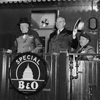
IntroductionIn the Begining Proxy Wars Secret Front Lines The Race for SpaceAmerica's Cold War CultureTimeline |
Cold Warriors |
“When history says that my term in office saw the beginning |
Harry Truman, January 15, 1953 |
|
Before handing the White House over to Dwight Eisenhower, Harry Truman reflected over the momentous events and pivotal decisions that crowded his presidency. He noted that hardly a day escaped him that was not “dominated by this all-embracing struggle.�? Each of the nine Cold War presidents would agree. The Cold War would absorb and constrain these administrations. In a war absent of an armed conflict between its two chief rivals, ideology and rhetoric often outflanked strategy and tactics. The times called for a robust presidency. In the Cold War, foreign affairs were paramount, destruction was but minutes away, and America needed to speak with a singular voice. Of its three federal branches, only the presidency, leader in foreign policy and commander-in-chief of the armed forces, fit the bill. |
The seven Soviet leaders during the Cold War era also would be absorbed and constrained by this war. Communism presumed an advantage because it did not have to contend with political opposition. Whereas the American presidency changed political parties five times between 1945 and 1991, each Soviet leader, from Stalin to Gorbachev, was its leader because he was head of the Communist Party, the only party permitted to rule in the USSR. The totalitarian state tried to suppress dissent; democracy embraced dissent as a political necessity. |
 |
Museum Home Library Home Education Center Home |